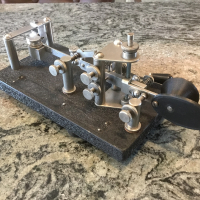SmartSDR v4.1.3 | SmartSDR v4.1.3 Release Notes
SmartSDR v3.10.15 | SmartSDR v3.10.15 Release Notes
The latest 4O3A Genius Product Software and Firmware
Need technical support from FlexRadio? It's as simple as Creating a HelpDesk ticket.
TX Power Meter QRP Scale...
Comments
-
I'd like to see greater granularity below 40W a) for digimodes and b) the UK has a 32W limit 1850-2000KHz.
Would also be useful for those not on full licences with limited permitted power.
Merry Christmas and Happy New Year.0 -
Jim,
Take a look and see if this is would address what are looking for. The snapshot below is from an idea to expand the scale, make it easier to read and also provide a digital readout. It has 24 votes so far. More info at this link.
https://community.flexradio.com/flexradio/topics/idea_to_improve_the_swr_and_power_scale_readability
Regards, Al / NN4ZZ
al (at) nn4zz (dot) com
1 -
AIUI, at present the power slider represents a % of max power and not a definite level.
Best wishes and thanks for your nice designs.
1 -
Al,
Of course, I did a few searches before posting, and your mock-ups were not included in the search results. All fine ideas.
And as Guy mentions, it also occurred to me that such granularity and low-level linearity might be much more than just a graphics red-do. But we can dream!
1 -
Great idea. Except skip the opt-out. What needs to be done is simply make the low power scale sufficiently different (color, shape of the bar, change in how many numbers, all of these) to make it obvious that the scale has changed. Do that and there's one less useless opt out in the world. Nobody really finds the current scale all that useful at low power.
The hard bit would be to make the automatic switch between them work (consider the power fluxuations in SSB for instance) so that it isn't annoyingly switching back and forth between them. Some sort of buffering/duration would have to be part of it even when opted-in.
0 -
Even given it is a percentage and not an absolute value (it is actually fairly close even as they promise it is not exact), it would still be a good thing to switch scales when the "percentage" is in the bottom 5 or 10 "percent" range.
0 -
Another solution would be to add another setting in the GUI that set the 100% point on the power slider. My old icom 703 had and adjustable max power setting in a setup menu (10w, 5w, 2.5w, 1w, 0.5w as I recall).
2 -
My max power is slightly different on each band, not by much, but enough for the power slider to be inaccurate. I normally use 30% on the power slider for JT65 work - there is approx 5-10 W difference between my 'best' band and the 'worst'. That difference is greater at 100%. I'd rather have an accurate power meter than % slider.
0 -
But what if you are doing true QRP with JT65? It arises two ways. 1. Naturally, in the obvious way you expect. 2. Feeding an amplifier at low total power. I find it a very nice thing to "buffer" the rig through an amplifier at all times. And, JT9, in particular, is a high duty cycle mode (nearly key down in practice), so even asking a 500 watt amp to put out 20 or 30 watts is a lot of load (and a load I like to move it from the rig to the amp when I can). 1 watt on the Flex drives 20 or 30 on my Alpha and 10 or 20 on my "brick" amp.
0 -
Asking a 100-watt transceiver to accurately go down to well under five watts may not be practical. A better way is to run the rig at, say, an easier-to-measure five watts, then use an RF pad to get down to a watt or less. Such pads are used all the time in broadcast transmitters to a) run the exciter at a constant level, and b) smooth out any slight mismatches between the exciter and the amplifier input.
By the way, I use JT9 frequently at five watts (and sometimes 10 to 15 watts for QRO!), and the fan on my 6300 never changes. The 6300 is rated at 100 watts for RTTY, so I’m not the least bit concerned with running 10 or 15 watts.
And I do like Mark’s setpoint idea for output power levels. Switching to a 10-watt 100% point certainly could switch the scale at the same time, doing away with my questionable “auto” scale switching idea. The engineering folks could also use this to address any transmitter non-linearities at lower levels.
0 -
I would also like to see an auto scaling watt meter.0
Leave a Comment
Categories
- All Categories
- 381 Community Topics
- 2.1K New Ideas
- 632 The Flea Market
- 8.3K Software
- 126 SmartSDR+
- 6.4K SmartSDR for Windows
- 185 SmartSDR for Maestro and M models
- 430 SmartSDR for Mac
- 272 SmartSDR for iOS
- 259 SmartSDR CAT
- 195 DAX
- 382 SmartSDR API
- 9.3K Radios and Accessories
- 40 Aurora
- 265 FLEX-8000 Signature Series
- 7.2K FLEX-6000 Signature Series
- 955 Maestro
- 56 FlexControl
- 866 FLEX Series (Legacy) Radios
- 927 Genius Products
- 464 Power Genius XL Amplifier
- 338 Tuner Genius XL
- 125 Antenna Genius
- 297 Shack Infrastructure
- 209 Networking
- 460 Remote Operation (SmartLink)
- 144 Contesting
- 788 Peripherals & Station Integration
- 140 Amateur Radio Interests
- 1K Third-Party Software


